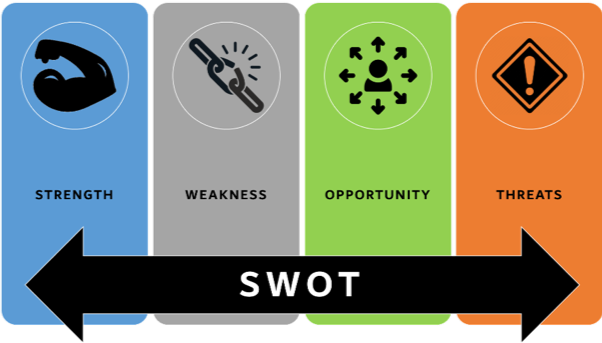SWOT is an acronym for Strengths, Weaknesses, Opportunities, and Threats. Thus, this fact-based analysis leads to fresh perspectives, and new ideas to achieve success.
It is an instrument used by an organization to achieve an external diagnosis, to identify the opportunities and threats present in the environment; followed by an internal diagnosis to identify the strengths and weaknesses of the strategic activity. If properly diagnosed it provides a detailed insight of all the aspects and factors of present environment and strategic activities.
The four elements of SWOT are:
Strengths:
This is the S of SWOT. Strengths are the positive traits or advantages of an organization over competitors, Market, Finance and other variables which makes the business strong and helps achieving their goal.
Weaknesses
This is the W of SWOT which lets the organization introspect or discover the areas where there is deficiency. It lets the organization decide that whether it is beneficial to work on these weaknesses and improve them or they can be ignored. Feedbacks from external and internal sources also help in to make decisions on the same operations are analyzed too to identify the weak spots which are slow, ineffective and don’t add value.
Improving on theses helps to strengthen the business and achieve the ultimate goal.
Opportunities
This is the O of SWOT. The literal meaning of opportunity means ‘a situation in which it is possible for someone to do something that they want to do’. In terms of an organization, the external factors that are possible chances for it to grow are its opportunities. These may vary from internal to external factors too. These opportunities, approached correctly, can contribute in success of the organization.
Threats
This is the T of SWOT. These are predicted external threats and obstacles which can impact the business in near future. These points may depend on competition in the market, competitors, government rule changes, technological changes etc.
How to Do a SWOT Analysis?
Preparing a SWOT team by a diverse group of employees with different perspectives, they put together in an organization to provide realistic data points for better analysis. The team should cut back and prioritize ideas to focus on the most significant and impactful actions and solutions.
This analysis is essential instrument for a Lean Manager and for the Management Committee.



